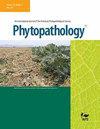求助PDF
{"title":"Analysis of the Genetic Variation and Geographic Distribution Patterns of <i>Xanthomonas citri</i> pv. <i>citri</i> Strains in Citrus Production in Burkina Faso.","authors":"Kevin Ben Fabrice Zerbo, Florence Yameogo, Issa Wonni, Irénée Somda","doi":"10.1094/PHYTO-04-24-0121-R","DOIUrl":null,"url":null,"abstract":"<p><p>It is essential to have a thorough knowledge of the genetic variation among different strains of <i>Xanthomonas citri</i> pv. <i>citri</i>, which is responsible for causing citrus bacterial canker. This understanding is important for studying disease characteristics, population structure, and evolution and ultimately for developing sustainable methods of control. A total of 48 strains obtained from citrus production areas in Burkina Faso in 2012, 2020, and 2021 were subjected to Polymerase Chain reaction (PCR) tests using specific primers. The aim was to examine the distribution of type 3 effectors and determine the geographical origins of the strains. The examination of the distribution of type 3 non-transcription-activator-like effectors (TALEs) revealed a broader range of strains obtained in 2020 and 2021 than in 2012. However, all the strains possessed a shared set of three genes, specifically, XopE2, XopN, and AvrBs2. Furthermore, all examined effectors were observed in the Bobo-Dioulasso region. Regarding the characterization of TALEs, two profiles containing two to three TALEs were discovered. Profile 1, consisting of two TALEs, was found in 37 <i>X. citri</i> pv. <i>citri</i> strains, whereas Profile 2, comprising three TALEs, was detected in 11 strains. Among the three TALEs (A, B, and C) that were identified, TALEs B and C were present in all the strains. The correlation matrix indicated a positive association between the type 3 effector content of strains and the duration of their isolation. Principal component analysis revealed a limited organization of the strains under investigation. [Formula: see text] Copyright © 2024 The Author(s). This is an open access article distributed under the CC BY-NC-ND 4.0 International license.</p>","PeriodicalId":20410,"journal":{"name":"Phytopathology","volume":" ","pages":"2024-2032"},"PeriodicalIF":2.6000,"publicationDate":"2024-09-01","publicationTypes":"Journal Article","fieldsOfStudy":null,"isOpenAccess":false,"openAccessPdf":"","citationCount":"0","resultStr":null,"platform":"Semanticscholar","paperid":null,"PeriodicalName":"Phytopathology","FirstCategoryId":"97","ListUrlMain":"https://doi.org/10.1094/PHYTO-04-24-0121-R","RegionNum":2,"RegionCategory":"农林科学","ArticlePicture":[],"TitleCN":null,"AbstractTextCN":null,"PMCID":null,"EPubDate":"2024/8/14 0:00:00","PubModel":"Epub","JCR":"Q2","JCRName":"PLANT SCIENCES","Score":null,"Total":0}
引用次数: 0
引用
批量引用
Abstract
It is essential to have a thorough knowledge of the genetic variation among different strains of Xanthomonas citri pv. citri , which is responsible for causing citrus bacterial canker. This understanding is important for studying disease characteristics, population structure, and evolution and ultimately for developing sustainable methods of control. A total of 48 strains obtained from citrus production areas in Burkina Faso in 2012, 2020, and 2021 were subjected to Polymerase Chain reaction (PCR) tests using specific primers. The aim was to examine the distribution of type 3 effectors and determine the geographical origins of the strains. The examination of the distribution of type 3 non-transcription-activator-like effectors (TALEs) revealed a broader range of strains obtained in 2020 and 2021 than in 2012. However, all the strains possessed a shared set of three genes, specifically, XopE2, XopN, and AvrBs2. Furthermore, all examined effectors were observed in the Bobo-Dioulasso region. Regarding the characterization of TALEs, two profiles containing two to three TALEs were discovered. Profile 1, consisting of two TALEs, was found in 37 X. citri pv. citri strains, whereas Profile 2, comprising three TALEs, was detected in 11 strains. Among the three TALEs (A, B, and C) that were identified, TALEs B and C were present in all the strains. The correlation matrix indicated a positive association between the type 3 effector content of strains and the duration of their isolation. Principal component analysis revealed a limited organization of the strains under investigation. [Formula: see text] Copyright © 2024 The Author(s). This is an open access article distributed under the CC BY-NC-ND 4.0 International license.
布基纳法索柑橘生产中柑橘黄单胞菌(Xanthomonas citri pv. citri)菌株的遗传变异和地理分布模式分析。
全面了解导致柑橘细菌性腐烂病的柑橘黄单胞菌 pv. citri(Xcc)不同菌株之间的遗传变异至关重要。这种了解对于研究病害特征、种群结构和进化,以及最终开发可持续的控制方法非常重要。使用特定引物对 2012 年、2020 年和 2021 年从布基纳法索柑橘产区获得的 48 株菌株进行了聚合酶链式反应(PCR)测试。目的是检查 3 型效应物(T3E)的分布情况,并确定菌株的地理来源。对 3 型非转录激活子样效应器(TALEs)分布的检测显示,2020 年和 2021 年获得的菌株比 2012 年的范围更广。不过,所有菌株都拥有一组共享的三个基因,具体为 XopE2、XopN 和 AvrBs2。此外,在博博迪乌拉索地区观察到了所有被检测的效应因子。关于 TALEs 的特征,发现了两个包含两到三个 TALEs 的剖面。在 37 株 Xcc 菌株中发现了由两个 TALEs 组成的剖面 1,而在 11 株菌株中发现了由三个 TALEs 组成的剖面 2。在已确定的三个 TALE(A、B 和 C)中,TALE B 和 C 存在于所有菌株中。相关矩阵表明,菌株的 T3E 含量与其分离时间呈正相关。主成分分析表明所研究菌株的组织结构有限。
本文章由计算机程序翻译,如有差异,请以英文原文为准。


